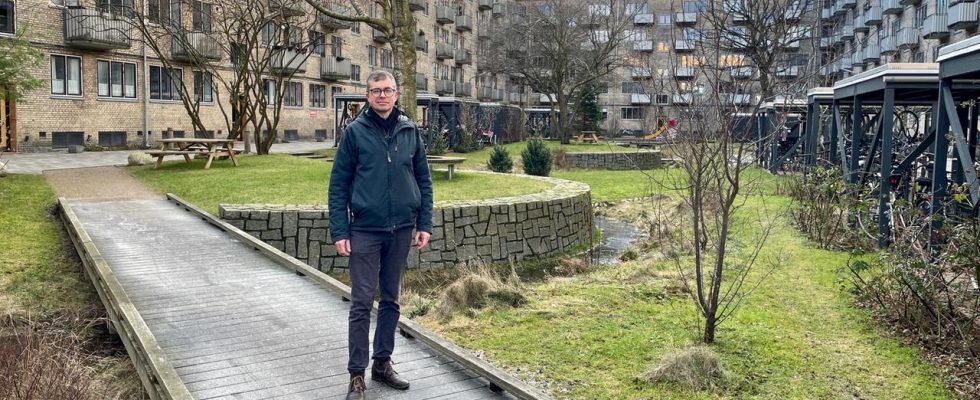A devastating cloudburst in 2011 forced Copenhagen residents to rethink their approach. Since then, parks and courtyards have been converted into large reservoirs – but they retain their original use.
By Julia Waschenbach
At first glance, Enghave Park at the western end of Copenhagen is a completely normal park. On a sports field, young people are kicking a ball back and forth, families are out and about with strollers, owners are with their dogs. But when there is a cloudburst, the park turns into a gigantic bathtub. It can then hold up to 23 million liters of water that would otherwise run into basements or apartments.
The architect Flemming Rafn Thomsen and his office “Tredje Natur” (in German: “Third Nature”) have taken care of this: “The park is part of a big cloudburst plan. All water that arrives in this part of Copenhagen should be here “Enghave Park will be absorbed. This means that the park plays a major role in the plan to protect Copenhagen against flooding.”
A sports field as a water basin
The architects lowered a sports field, a rose garden and a small lake so that they can absorb more water in heavy rain. A low wall runs around Enghave Park. In the event of a once-in-a-century cloudburst, the entire park can be sealed off with mechanical gates so that it functions as a huge collecting basin. The water can now be almost waist high without it getting outside, says architect Thomsen.
“Such extreme cloudbursts are rare, and that’s why it was important to us that everything was designed so that it could be used not one percent of the time, but 100 percent of the time,” explains Thomsen. The sunken sports field has stairs on the sides, similar to an amphitheater. Their different sized steps would invite you to play and linger. “People roller skate and skateboard here, people dance here. It should be a universal design.”
Architect Thomsen in Enghave Park, which his office redesigned.
Multifunctional architecture
Hardly anything in the park serves only one purpose. Rainwater from the neighborhood’s gutters is collected in an underground basin. It is used to irrigate the rose garden. And the city sweepers can tap it from a corner of the park to clean the streets.
The principle runs through the approximately 250 projects of the Copenhagen Cloudburst Plan. A small part of the measures is financed through taxes, the largest part through household payments to water suppliers, says Rasmus Dragenberg. He is responsible for so-called climate adaptation at the municipality.
“The special thing that makes people so curious is that we are simultaneously renewing the urban space while we want to protect it from extreme weather. We are not only creating catch basins, but also renovating the city’s courtyards, parks and squares. It’s simply a new factor that has come into play that you also have to take into account,” explains Dragenberg.
The “sponge city” as a response to the disaster
The city came up with this plan to make Copenhagen a “sponge city” after a catastrophe, a historic cloudburst in 2011. On a Saturday in July, more than 50 millimeters of rainwater per square meter rained down on the city in half an hour in some places. Streets, basements, shops and part of the highway were flooded. The damage was immense.
The courtyard in the Østerbro district, where Mads Faber Henriksen’s apartment is located, was also under water. “When the rain came, all the cellars were full. The residents ran down into the cellars and saw their records competing with the rats. That opened many people’s eyes to the fact that something like this could happen,” says Henriksen.
Neighborhood had to be convinced
And it shouldn’t happen again. Not in Copenhagen and not in Henriksen’s courtyard. So he went door to door and convinced his neighbors to apply together to the city for money for renovation.
“This used to be a pretty run-down courtyard. People parked their cars here, but nobody wanted to stay here. The children didn’t want to play here,” remembers Henriksen. “And then we were given the opportunity to go on this dream journey and have a say in what should happen.”
Now the inner courtyard is one thing above all: green. The water drains from the gutters onto the green area, where a small lake forms in the planted ditches in rainy weather. Biotopes like this have existed all over Copenhagen since the Cloudburst Plan began. And there are many more planned.
Julia Waschenbach, ARD Stockholm, tagesschau, February 13, 2024 10:43 a.m

